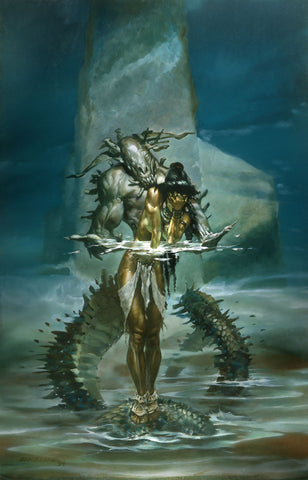Earthdawn Core: A sad reminder of what could have been...
Share


In the beginning, there was Shadowrun… and it was good. Then, in 1993, FASA created Earthdawn as the semi-precursor to their breakout cyberpunk hit. Much like the world of Conan reflects an age of Earth long forgotten, Earthdawn filled this same pre-history, which I have to say was infinitely cool considering the story from which Shadowrun was born.
However, somewhere along the line FASA took a turn that would unfortunately doom the game to a moderate hit that fell quickly into mediocrity. To me, FASA had no concept of its own OGL, and thus failed to realize that the game mechanics that made Shadowrun so smooth [especially by the 2nd edition release] were the perfect transition piece to make Shadowrun players infinitely comfortable with the new fantasy world of Earthdawn.
To this day I will never understand their decision to create a much more contrived and harder to understand and play mechanic for this game since it links so directly to Shadowrun in the first place. Obviously, the brain trust at Wizards of the Coast would get the hint years later with D20, but in 1993 the gaming industry was far too concerned with individuality for the sake of proprietary license.
Whatever the case, Earthdawn failed to capture a large enough audience and the game, even though still produced today, is more an oddity than a functional system.
The art, however, is another matter entirely, especially for the core rules book of the game. Art Directed by Jeff Laubenstein, the book is a true labor of artistic love. I have no doubt in my mind that this was Laubenstein’s opus, and he pulled out all the stops in the visual creation of the universe.
First and foremost, we need to take a look at cover artist Rick Berry. Very few fantasy illustrators go on to be modern gallery artists, but Rick is the exception that proves the rule. His art is so incredibly advanced and sublimely beautiful it baffles me to find him doing work on an RPG at all. Still, not only does he render an astounding horror-inspired cover that is a complete divergence from what a fantasy RPG cover should be [yet it works!], but also does a dozen full-page chapter header illustrations that simply take ones breath away.
Besides Berry, Laubenstein packs the book with over twenty artists that provide both b/w illustrations and full-page color plates on nearly every page of the book. Among these are industry standards like Joel Biske, David Martin, Jim Nelson, Tony Szcczudlo, Mike Nielsen, Tom Baxa, Larry MacDougall, and the unsung fantasy hero that is Mark Nelson.
Just writing those names in one place gives me goosebumps, and on top of them artist Janet Auliso does some of the most outstanding full color images of her career as well.
If Earthdawn was a commercial failure, one cannot blame the art, of that I’m certain.
My only knock on the book is the inclusion of FASA regulars Rick Harris and Earl Geier who I don’t think bring a level of artistic talent to the table that stands with the rest of the artists involved in the project.
In all, Earthdawn is a sad masterpiece, a game that fell directly into the teeth of poor game management and the industry juggernaut that was the growing CCG craze.
Artistic Rating: 4 [out of 5]


40 comments
cialis canadian pharmacy https://canadacialisstore.com/ counterfeit canadian drugs cialis
erectile herbs and vitamins https://plaquenilx.com/ best erectile dysfunction medication
used to treat malaria chloro https://chloroquineorigin.com/ is chloroquine phosphate the same as hydroxychloroquine
viagra sin recetas en farmacias de canada https://canadaviagrastore.com/ how to buy teva sob for viagra in canada
buy tadalafil https://elitadalafill.com/ tadalafil daily use